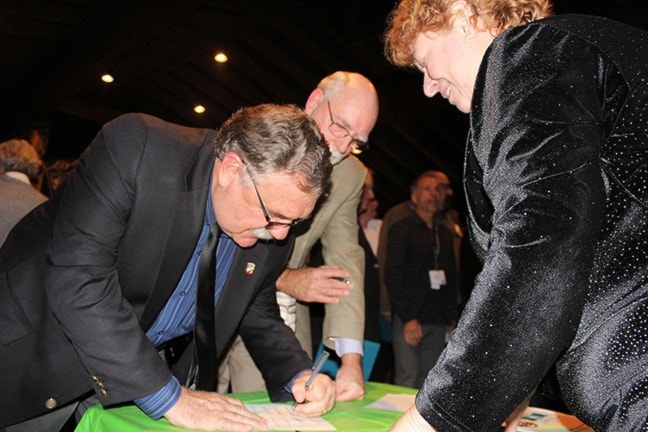Terry Farrell
Record staff
The K’ómoks First Nation Big House on Dyke Road was filled to capacity Friday night, as nearly 400 people attended the Community Witnessing Ceremony for the 2016 Critical Incident Response Protocol.
More than 120 individuals, representing community groups, businesses and associations, signed the document, a renewal of the original 2009 CIRP, which was signed by 43 members of the public.
Led by the efforts of the Community Justice Centre directors, and, in particular, the chief administrator, Bruce Curtis, the Renewal of the Comox Valley Critical Incident Response Protocol Project served to revise the original document “to accommodate changes in society and provide the opportunity to include more groups and individuals within the community.”
The Critical Incident Response Protocol is a proclamation of acceptance of our community’s diversity, be that of religious belief, ethnicity, sexual orientation/identification or socio-economic status.
The renewal project took the CJC team nearly 18 months to complete. Curtis said the evolution of social media was the catalyst for the update.
“Certainly the stimulus for doing the renewal was the emergence of several styles of social media hatred,” he said. “We did research on how to approach social media hatred and drafted up some amendments to the protocol that would address the social media issue, circulated those to the original (2009) signatories, as well as a number of other groups, as a draft, for their input, then finalized a final draft, in August. It was quite a long process. I think we started on it in March of 2015.”
Curtis was pleased with the increase in community involvement in the renewal, not only from the simple increase in numbers of signatories, but also in where those signatories came from.
“Thrilled - absolutely delighted in the increased numbers,” he said. “When we set out on this project, I had hoped to reach 100 signatories. So we reached almost 50 per cent more than our goal.
“I was particularly pleased that this time, a number of service clubs signed onto the protocol, which we didn’t have the last time – a Rotary club, a Kin club, a Lion’s club. There was also a wider array of faith communities signed on as well this time.”
There was also one more municipality this time. The City of Courtenay, which did not participate as a signatory for the original CIRP in 2009, signed the document on Friday night.
“We are happy to see that the City of Courtenay has joined,” said Curtis, saying the addition of the City means all four governances are now on board with the CIRP. “And it goes beyond that. K’ómoks First Nation and Mamalilikulla signed on Friday as well. K’ómoks was an original (2009) signatory, but Mamalilikulla is new this year, so that’s very encouraging.”
The Comox Valley’s CIRP is one of approximately 40 such protocols in communities across the province, decrying hatred and intolerance. None of the others come anywhere near the Comox Valley’s participation numbers.
“Most of those 40 or so protocols have signatories of five, or six, maybe nine or 10,” said Curtis. “Our original one had 43, because we specifically went out to engage the community, in a whole bunch of sectors that were not necessarily approached by the other communities. We had a sector of faith communities; we had a sector of cultural organizations; a sector of social service delivery service agencies ... as well as an educational sector. North Island College and the school board both signed on.
“And on the list this time, those are all preserved, and extended. The number (of participants) in the Comox Valley is astronomical, relative to the other protocols that continue to exist in other communities.”
Curtis said there is a follow-up project in the works, which involves identifying sources where anyone with concerns of persecution can go to for support, akin to a “Safe Harbour” program.
“There will be development of a series of posters and such that will identify venues and sources that you can take your concerns to,” he said. “We are just starting that but probably in February or March we will be sending that material out to the signatory groups, who will then be able to put something ... in their windows.”
